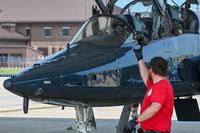Not many planes are as loved by ground troops as are the ungainly close air support warriors known as A-10s. With the war in Afghanistan heating up in October came potentially disastrous reports that many Warthogs, as the planes are affectionately known, were suffering serious wing cracks and would have to be grounded while the problem was studied.
Today comes word from Air Force Lt. Gen. Norman Seip, commander of the Twelfth Air Force, that most Hogs are back in the air or soon will be. But there are many planes still grounded, especially those with so-called thin wings. Seip told reporters this morning that the service has inspected 200 of 244 aircraft with thin wings. Of those, 40 percent remain grounded, 41 percent have been inspected and returned to flight and the remainder is "flyable and awaiting inspection." All questions should be resolved by June, he said, reiterating the service's earlier calculation on October that the planes should be fixed by then.
The so-called thick winged planes are faring better. Some 30 percent are still grounded, 23 percent will keep flying and the rest should be up by June. I asked the general if the Air Force had been able to meet demands for the A-10 from the combatant commanders. His answer was an unequivocal yes. "What started off as a pretty challenging logistical challenge, we've managed to bring it under control," Seip said. He did concede that they had to work hard to manage the fleet so that the service could keep enough pilots trained up and still use them blow up stuff on the ground. But both jobs got done, the general said.
In other comments, Seip said the Air Force definitely gets the message that Defense Secretary Robert Gates sent about UAVs -- namely that they need to get them into theater and they need to find the money to build more of them.
"The U.S. Air Force is all in. We understand Secretary Gates' direction," he said. As proof, he noted that 85 percent of the UAV capability is now in areas of responsibility, and 15 percent are in CONUS "to train future operators."








